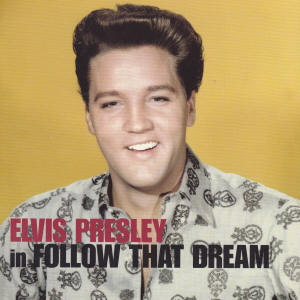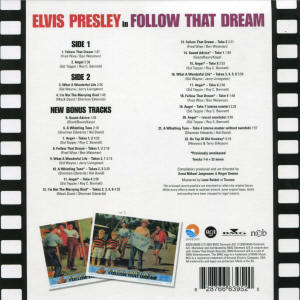

In 2004 Follow That Dream Records finally
released a special edition of the record that
gave the collector's label its name. The cd was
housed in a 5" digi-pak and accompanied by a
bookled with background information and photos.
Besides the tracks of the original release the
special editon also included "Sound Advice"
(released by RCA Victor in 1965 on the album
"Elvis For Everyone!") and "A Whistling Tune"
(re-recorded for "Kid Galahad").
Because the stereo masters were lost in the
vaults, FTD presents the tracks of the original
release in mono. These recordings were simply
remastered, which means interfering noises were
removed. The outtakes were recorded with multi
track equipment, so they had to be mixed before
they could be released. All this work was done
by Lene Reidel. With the releases of "The
Complete Elvis Presley Masters" (2010) and "The
RCA Album Collection" (2016) the sound could be
improved. However, back in 2004 FTD's special
edition of "Follow That Dream" was the best
sounding source of these tracks.
As usual I just deal with the bonus songs and
outtakes. For a review of RCA Victor's original
release tap
HERE.
Sound Advice
(bonus song)It's a children's
song in which the singer warns his listeners
that not every advice is a good one. The lyrics
play with the ambiguous word "sound". Elvis
needed six takes for the song written by Bill
Giant, Bernie Baum and Florence Kaye.
A Whistling Tune
(bonus song)
This happy song was penned by Edwards/David and
recorded within four takes. The whistling was
overdubbed later by Ray Walker, the bass singer
of The Jordanaires. Finally the song was
rejected, but later used in the movie "Kid
Galahad". For this project Elvis re-recorded the
it on October 26, 1961.
Angel
(takes 1 & 2)
After the take was announced Elvis and his
musicians coordinate themselves. On the first
take there is a stronger emphasize on the
rhythm. After 1.5 minutes Elvis gets lost in the
lyrics, stops and askes to hear what he has
recorded so far. The second take is complete,
the rhythm is not emphasized as much and the
arrangement of the harmony voices has been
changed.
Follow That Dream
(takes 1 & 2)
On the first attempt Elvis misses his cue. Take
2 works well and already sounds close to the
master. Here and there the king still needs to
work on his phrasing and he also doesn't sound
as enthusiastic as on the master take.
What A Wonderful Life
(takes 2 & 1)
Obviously FTD wanted to present a failed attempt
to record followed by a complete performance. So
they simply switched the chronological order of
the takes. On take 2 Elvis has a lump in the
throat and has to harrumph. The first take works
well, even though the king sings certain parts
different compared to the master.
A Whistling Tune
(takes 2 & 3)
The second attempt is nothing more than the
words "did you ever notice". The next try fails
because the pianist goofs up the intro. Take 3
is a complete performance, but Elvis has
troubles with the melody and his timing. There's
still a lot of work to do.
Angel
(take 4)
The take is announced, in the background someone
clears his/her throat. Because this also happens
while the intro is played, the recording is
stopped. The sound engineer doesn't regard these
failed attempts a separate take and keeps the
tape rolling. By now Elvis has warmed up to the
tune and delivers a strong performance.
I'm Not The Marrying Kind
(takes 2-4 & 6)
In funny voice Elvis derides the line "So I say
YOU KNOW WHAT?, she says WHAT?, I say WHAT"
which leads to a cancellation of take 2. The
next attempt fails because Elvis stumbles upon
the first words. He apologizes and the song is
started again. Now the king makes it through the
"what"-part, but fails a few seconds later. Take
4 also doesn't work because Elvis gets out of
step. The sixth try works quite well, at least
until the last few bars.
Follow That Dream
(take 3)
The pianist plays a few cords, we also hear some
studio talk. The performance itself works very
well, there are just a few minor things that
have to be ironed out.
Sound Advice
(take 1)
The tempo is much slower than on the master, so
the song drags a bit. In general "Sound Advice"
doesn't seem to challenge anyone.
Angel
(take 5)
Take 5 is a beautiful performance that could
easily have been chosen for release.
What A Wonderful Life
(takes 3-5 & splice of takes 6/7)
The drummer misses his cue, the second attempt
fails at the bridge. On take 4 the musicians
goof up the start and when the song finally gets
going there are so many timing mistakes that
it's cancelled in mid-song. Take 5 runs much
longer, but at some point Elvis gets out of step
and kills the attempt to record the song. The
track ends with a splice of take 6 and take 7.
The old magnetic tape was damaged, so FTD edited
take 6 and used the finale of take 7.
Angel
(take 6)
Another great performance that could have been
chosen for release.
Follow That Dream
(take 4)
Because the stereo master was lost, BMG used
take 4 on the album "Command Performances". At
the time it was wrongly labeled as "take 2".
It's a great performance with minimal
differences to the master.
Angel
(stereo master)
Here we get to hear take 7, which Elvis finally
selected as master take. Unfortunately something
went wrong with the digital transfer of the old
analogue tape, so the recording runs too slow.
Maybe a check of the product before release
would have helped.
Angel
(vocal overdub)
Elvis not just recorded "Angel" with his band
and the harmony singers, he also put a separate
vocal overdub on tape. The first take is stopped
in mid-song with the king calling for Bill
Porter (the sound engineer).
A Whistling Tune
(undubbed stereo master)
This is the tune without the whistling. We get
to hear take 4 as recorded live in the studio,
though FTD has cut the parts that were later
overdubbed by Ray Walker. I don't like this kind
of editing, because I think a collector's label
should present the recordings in their original
form.
On Top Of Old Smokey
Elvis sings the song for just a few seconds.
This wasn't done in a recording studio, but
directly on the movie set.
Verdict
The packaging and the booklet are great,
the sound quality is very good and we get a
bunch of interesting outtakes. However, one
of the tracks is running too slow and
another one was edited for no reason.

(C) Sony Music
Entertainment / Follow That Dream Records
![]()

